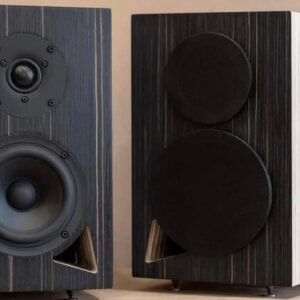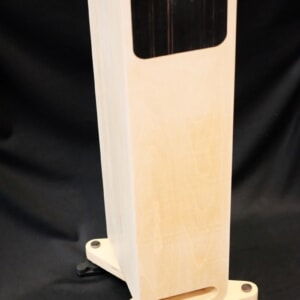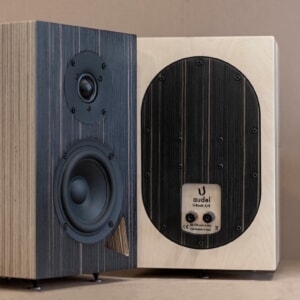The Challenge
The design brief for PQS 402 was to reproduce the sound of our Loreley model in a smaller loudspeaker using similar technology and so make our reference performance level products available to a wider audience. The PQS 402 succeeds in this. It can play prodigiously loud – up to 118dB and it can play very deep – down to 25Hz, whilst all the time retaining the delicacy and transparency that German Physiks loudspeakers are famous for.
The Problem
Because we wanted to cross over the DDD driver to the woofer between 220Hz and 140Hz, we had to find a way to build a very fast bass system that could match the speed of the DDD driver in the crossover region and also work down to 25Hz. To reproduce low bass at high levels a lot of air has be moved. This requires either a driver with a large surface area, which will be heavy and therefore not easy to move at the speed necessary to match the DDD driver, or a driver with a long excursion, which again will be heavy due to the rigidity required to withstand the necessary acceleration. Most loudspeaker designers solve this problem by producing a 3 way system. However, in a loudspeaker the size of the PQS 402, a 3 way solution would have been worse than a 2 way solution, due to the difficulty of making 3 drivers appear to be a single source. This is especially difficult with the mid and treble drivers, where the ear’s ability to locate position is very acute. It can be done, by why bother when you have a better solution?
The Solution
Our solution was to build a bass cabinet using a fast and powerful 10 inch driver and two 8 inch passive radiators. The 10 inch driver integrates flawlessly with the speed of the DDD and the passive radiators extend the bass response smoothly down to 25Hz as required. The final system comprises 2 bass cabinets that are mounted one on top of the other and stand between a top and a bottom plate. None of these components is attached to the other using screws or any other form of hard connection. Instead they are held together by system of interlocking collars. This combined with the fact that the two cabinets have different weights, as do the top and bottom plates, means that resonances are reduced to negligible levels compared to a solid structure. This arrangement is also very difficult to topple, which is a useful safety feature for customers who live in earthquake regions.
The DDD Driver
The DDD driver is used on all German Physiks loudspeakers and the same quality of driver is used on all models from our entry level product to the top of the range Gaudi. This revolutionary driver gives the same very important advantages to all German Physiks designs and is what sets them apart from our competitors.
The DDD driver’s very low moving mass enables it to operate linearly over an extremely wide frequency range. On the PQS 402 it covers the entire range from 215Hz upwards In a conventional design, this range would be covered by two or even three different types of driver and most importantly there would be a cross over point in the mid range, the area where our hearing is most sensitive. The DDD driver’s wide operating range allows this vital region to be kept free from the level and phase anomalies that multiple drivers and a necessarily more complex crossover would create. This enables the PQS 402, like all German Physiks loudspeakers, to produce very accurate and realistic stereo images.
Another key advantage of the DDD driver is that it is omni directional, so these excellent stereo images can be enjoyed from a wide range of listening positions, unlike conventional designs which have much smaller “sweet spots” due to the tendency of their drivers to beam the sound.
The DDD driver’s very low moving mass provides the further benefit of exceptional impulse and phase response characteristics and allows it to reproduce both the attack of the music and resolve low level detail very accurately. This is essential in order to faithfully reproduce the delicate nuances and timbral characteristics of a performance and make it sound like music, rather than just good hi-fi. The driver’s excellent impulse response also ensures that the stereo image remains focussed and stable, even when the loudspeaker is reproducing complex passages at high levels.
More information on the DDD driver, its development and advantages may be found on the Technology page of this web site.
Low Resonance Cabinet
Considerable effort has gone into creating a cabinet design that minimises the radiation of sound energy through its panels, as the smearing this causes would degrade the loudspeaker’s ability to resolve fine detail and thereby produce a sense of realism. The PQS 402’s cabinets are constructed from heavy panels of MDF with cross bracing fitted to critical points within the structure. To minimise residual vibration, Hawaphon damping sheets are attached to the inside face of each panel. Hawaphon is polymer sheet containing a matrix of small cells filled with very fine steel shot and was originally developed as an anti-surveillance measure for use in military and government buildings. It adds mass to the panel to reduce the resonant frequency and the ability of the shot in each cell to move against each other provides a very effective way of converting vibration energy into heat. Hawaphon achieves a broadband attenuation of structure-borne sound of more than 50dB, which is a remarkably high figure.
To damp resonances of the air within the cabinet, the whole of the inside of the cabinet is lined with a thick layer of high density felt.
Patented Crossover Design
The crossover provides a wide range of adjustment to allow the PQS 402 to be optimally set up to suit the user’s listening room. The high frequency level may be adjusted over the range -2dB to +4dB in 4 steps and the low frequency level may be adjusted over the range +10dB to 0dB in 3 steps. The low frequency control has no effect above 100Hz and we have applied for 2 patents to cover the novel approach that we developed to achieve this. Both controls are facilitated by high quality jumpers located on the loudspeaker’s rear panel and may be quickly and easily adjusted.
Hand Finished for the Ultimate Quality
The PQS 402 is available in the customer’s choice of select, hand matched hardwood veneers. These are carefully applied to the MDF panels prior to the construction of the cabinets. This method results in some wastage of material and thus adds to the manufacturing cost, but results in the finest possible furniture grade finish. A multi-layer lacquer coat which is hand polished to a high lustre finish is available as an optional extra. Please see the Finishes page for more details.
Special Order Version
A special order version of the PQS 402 is available with a laminated carbon fibre reinforced cabinet. Multiple layers of bi-directional, resin impregnated carbon fibre are applied to the cabinet’s panels using techniques originally developed for the aircraft industry. A multi-layer lacquer is then applied and hand polished to a high lustre. This produces a cabinet that is immensely rigid and strong, as well as being practically free from resonances within the audio frequency band. This further increases the already very high level of transparency achieved by the PQS 402. This version is fitted with carbon fibre DDD drivers, which extend the frequency response to 24,000Hz and the maximum output level to 118dB.





